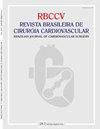Dexmedetomidine Leads to the Mitigation of Myocardial Ischemia/Reperfusion-Induced Acute Lung Injury in Diabetic Rats Via Modulation of Hypoxia-Inducible Factor-1α
IF 1.2
4区 医学
Q4 CARDIAC & CARDIOVASCULAR SYSTEMS
Revista Brasileira De Cirurgia Cardiovascular
Pub Date : 2022-05-23
DOI:10.21470/1678-9741-2020-0591
引用次数: 2
Abstract
Introduction The objective of this study is to investigate the protective mechanism of dexmedetomidine (Dex) in myocardial ischemia/reperfusion (MIR)-induced acute lung injury (ALI) of diabetic rats by inhibiting hypoxia-inducible factor-1α (HIF-1α). Methods Initially, healthy male Sprague Dawley rats were treated with streptozocin to induce diabetes. Then, three weeks after the induction, Dex or lentiviral vector (LV)-HIF-1α was injected into the rats 30 minutes prior to the MIR modeling. After four weeks, lung tissues were harvested for pathological changes observation and the wet/dry weight (W/D) ratio determination. Afterwards, oxidative stress indicators and pro-inflammatory factors were measured. In addition, HIF-1α expression was assessed by immunohistochemistry and western blot analysis. Results Dex could suppress inflammatory cell infiltration, improve lung tissue structure, reduce pathological score and the W/D ratio, and block oxidative stress and inflammatory response in MIR-induced ALI of diabetic rats. Besides, Dex could also inhibit HIF-1α expression. Moreover, Dex + LV-HIF-1α reversed the protective role of Dex on diabetic MIR-induced ALI. Conclusion Our study has made it clear that Dex inhibited the upregulation of HIF-1α in diabetic MIR-induced ALI, and thus protect lung functions by quenching the accumulation of oxygen radical and reducing lung inflammatory response.右美托咪定通过调节缺氧诱导因子-1α减轻糖尿病大鼠心肌缺血/再灌注引起的急性肺损伤
引言本研究旨在探讨右美托咪定(Dex)通过抑制缺氧诱导因子-1α(HIF-1α)对糖尿病大鼠心肌缺血/再灌注(MIR)诱导的急性肺损伤(ALI)的保护作用机制。方法健康雄性Sprague-Dawley大鼠先用链脲佐菌素诱导糖尿病。然后,在诱导后三周,在MIR建模前30分钟将Dex或慢病毒载体(LV)-HIF-1α注射到大鼠中。4周后,采集肺组织用于病理变化观察和湿/干重(W/D)比测定。之后,测量氧化应激指标和促炎因子。此外,通过免疫组织化学和蛋白质印迹分析评估HIF-1α的表达。结果地塞米松能抑制炎症细胞浸润,改善肺组织结构,降低病理评分和W/D比,阻断氧化应激和炎症反应。此外,Dex还能抑制HIF-1α的表达。此外,Dex+LV-HIF-1α逆转了Dex对糖尿病MIR诱导的ALI的保护作用。结论Dex在糖尿病MIR诱导的ALI中抑制HIF-1α的上调,从而通过抑制氧自由基的积累和减轻肺部炎症反应来保护肺功能。
本文章由计算机程序翻译,如有差异,请以英文原文为准。
求助全文
约1分钟内获得全文
求助全文
来源期刊

Revista Brasileira De Cirurgia Cardiovascular
CARDIAC & CARDIOVASCULAR SYSTEMS-SURGERY
CiteScore
2.10
自引率
0.00%
发文量
176
审稿时长
20 weeks
期刊介绍:
Brazilian Journal of Cardiovascular Surgery (BJCVS) is the official journal of the Brazilian Society of Cardiovascular Surgery (SBCCV). BJCVS is a bimonthly, peer-reviewed scientific journal, with regular circulation since 1986.
BJCVS aims to record the scientific and innovation production in cardiovascular surgery and promote study, improvement and professional updating in the specialty. It has significant impact on cardiovascular surgery practice and related areas.
 求助内容:
求助内容: 应助结果提醒方式:
应助结果提醒方式:


